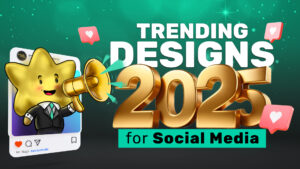In the world of design and communication, choosing the right font is a crucial decision that can make or break the effectiveness of your message. Fonts are more than just letters; they convey emotions, personality, and style. Whether you’re creating a website, designing a logo, or crafting a document, here’s a comprehensive guide on how to choose the right font.
What are Fonts?

Fonts are collections of characters which includes letters, numbers, symbols, and special characters, designed with a consistent style and size for use in printed or digital text.
They are essential for conveying visual information through typography and play a crucial role in shaping the appearance and readability of written content.
How does fonts help a brand?

Fonts serve the purpose of infusing personality into your brand name, enhancing the visual appeal of your design, and effectively conveying your core message to attract your audience.
If your audience can’t instantly recognize and engage with the text in your marketing graphics, they are unlikely to invest the effort in deciphering it. Therefore, the selection of legible fonts is of utmost importance.
While body text fonts may not possess the same prominence as headers, they still need to maintain readability, even from a distance and at a quick glance.
The important Key factors

Functionality: The functionality of a typeface varies depending on its size and purpose. While display fonts can be stunning in larger sizes, they may lose legibility when scaled down to any size.
Versatility: Designers often seek versatile fonts to ensure consistent and effective communication in various projects, from print materials to digital content and beyond. These fonts can seamlessly transition between different design applications, making them valuable tools for creating cohesive and impactful visual identities.
Body Text Legibility: While headers and larger text may grab attention, don’t neglect the legibility of body text. Even smaller text should be designed to be easily read at a glance, especially in marketing materials where you want to get your message across efficiently.
Font Thickness: the visual thickness or heaviness of the characters in a typeface. Fonts come in various weight options, which can range from very thin to extremely bold. Font weight is an essential design element that can convey different emotions, create emphasis, and affect the overall aesthetic of text.
Types of Font styles?

When categorizing fonts, they are often grouped into three major categories: serif fonts, sans-serif fonts, and script fonts. Each category has its own distinctive characteristics and is suited for different design purposes
Serif Fonts
Serif fonts are characterized by the small decorative strokes or “serifs” at the ends of characters. They are often considered more traditional and formal in appearance. Serif fonts are commonly used in print materials such as books, newspapers, and magazines. Examples of serif fonts include Times New Roman, Garamond, Baskerville
Sans-Serif Fonts:
Sans-serif fonts do not have the decorative serifs at the ends of characters. They are known for their clean, modern, and minimalist appearance. Sans-serif fonts are popular for digital and web design, as well as in user interfaces (UI) and signage. Examples of sans-serif fonts include Helvetica, Futura, Gotham
Script Fonts:
Script fonts mimic handwriting or calligraphy and have a flowing, cursive style. They can range from formal and elegant scripts to more casual and playful styles. Script fonts are often used for special occasions, invitations, and decorative elements. Examples of script fonts include Cookie, Rowdex and SignPainter.
Licensing and Accessibility

Lastly, be aware of licensing restrictions when using fonts, especially for commercial projects. Always respect the terms and conditions set by font designers and foundries.
Additionally, consider accessibility. Use fonts that are legible for all audiences, including those with visual impairments. Make sure there’s enough contrast between text and background colors and provide alternatives for important information.
Conclusion:
In conclusion, choosing the right font is a critical aspect of effective design and communication. By understanding your purpose, exploring font categories, considering pairings, testing, and being mindful of licensing and accessibility, you can enhance the impact of your message and create visually appealing designs that resonate with your audience. So, go ahead, choose your fonts wisely, and let your creativity flow!





